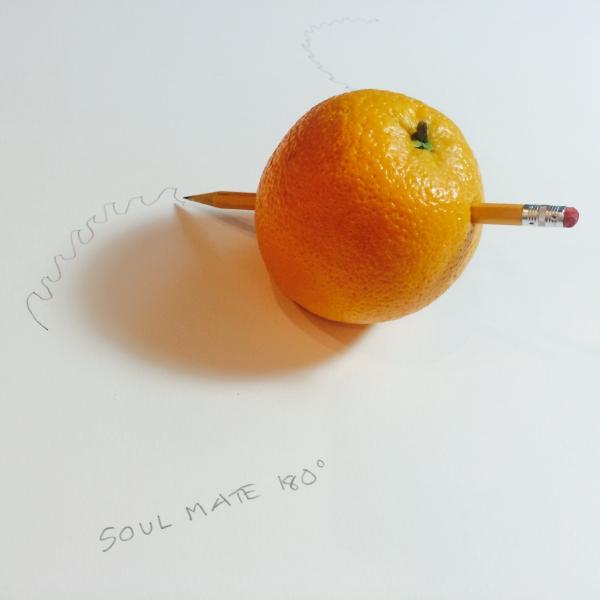For many years, humanity has speculated about what lies on the opposite side of the earth. For her Art + Technology Lab project and installation, Soul Mate 180°, artist Kirsten Mosher researched LACMA's antipode—the point on the earth that is diametrically opposed to it—to explore the tension between what can been seen and what is imagined. We caught up with Mosher in her studio in western Massachusetts, where she has been writing a novel related to the project.
This is the second installment of our Q&A with Art + Technology Lab grant recipient Kirsten Mosher. This Saturday, January 11, at 1 pm, Mosher will be giving a tour of her project, Soul Mate 180°, currently on view on the museum's BCAM Lawn.
Your initial project proposal to the Lab featured an image of a pencil piercing an orange. What's the story behind this image? How did it evolve into the installation we have at LACMA today?
I was looking for a direct way of expressing the concept of antipode without using a map or globe, which I felt would over emphasize specific places since an antipodal connection can happen with any two opposite places. I tend to gravitate toward low tech tools. Although I would eventually use much higher tech systems than a pencil and an orange, it was a good place to start. Every step you take establishes a new other side. On the other hand, I love that no matter where one steps in the United States, the other side is always a specific wave cresting somewhere in the Indian Ocean.
Kirsten Mosher, from Soul Mate 180°, video: Kirsten Mosher
Part of the Soul Mate installation includes a text piece on a column that visitors can read from the balcony of BCAM. This is not your first time working with text at LACMA. You participated in the exhibition A is for Zebra that took place at our satellite gallery at Charles White Elementary School. Please tell us about what you did for that show. How does it relate to the text piece in Soul Mate?
In 2011, I was commissioned to create an installation for the exhibit A is for Zebra curated by Jose Luis Blondet. I loved the concept of the exhibition, working with alphabets, the sense and nonsense of how language is shaped. It was a great opportunity to continue to develop my work with my Gumhead characters, chewed up and spit out wads of gum stuck to surfaces with black Sharpie drawn legs and language. Three stop-motion animations wrapped around corners and along the baseboards of the gallery. And a large-scale mural project on the most pipe-laden wall of the gallery alphabetically indexed the Gumheads' parkour style acrobatics on the appurtenances (pipes, light switches, fire escape valves) of the back wall.
It wasn’t my first time working with Jose. We met at Dia where I worked and lived since I was in my early twenties, soaking up concepts around earthworks and measured space. Dia was really a home for me for over 30 years. Jose and I worked on a number of education projects at Dia:Beacon. When he moved to Boston Center for the Arts in 2008 he invited me to create Free Parking, a solo exhibit that included wall murals, video, painting, and a highway that extended from outside to inside the gallery.
With Soul Mate 180°, the story is not only about the architecture of this side and that side, but what’s in between and beyond. It’s geographic space but also the cultural and political space. That’s the framework of the excerpt on the red column on the balcony at BCAM. In my novel, also titled Soul Mate 180°, Myra, the protagonist, is thrown into a world defined by polarities—this side and that side, black and white, etc. The marble sculpture, the idea of marking geographic polarities, allows for the possibility of seeing the gray areas beyond them. The text piece, which is taken from a rant of Myra's, is a degree of gray.
The Art + Technology Lab is presented by

The Art + Technology Lab is made possible by Accenture and Snap Inc.
Additional support is provided by SpaceX and Google.
The Lab is part of The Hyundai Project: Art + Technology at LACMA, a joint initiative exploring the convergence of art and technology.
Seed funding for the development of the Art + Technology Lab was provided by the Los Angeles County Quality and Productivity Commission through the Productivity Investment Fund and LACMA Trustee David Bohnett.



